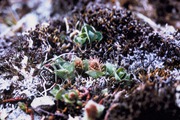580217 Salix arctica Pall.
Distribution
Northern Iceland: Frequent
Northern Fennoscandia: Rare
Polar Ural - Novaya Zemlya: Frequent
Yamal - Gydan: Rare
Taimyr - Severnaya Zemlya: Frequent
Anabar - Onenyo: Rare
Kharaulakh: Frequent
Yana - Kolyma: Rare
West Chukotka: Scattered
Wrangel Island: Presence uncertain
South Chukotka: Scattered
East Chukotka: Frequent
Western Alaska: Frequent
Northern Alaska - Yukon: Frequent
Central Canada: Frequent
Hudson Bay - Labrador: Frequent
Ellesmere Island: Frequent
Western Greenland: Scattered
Eastern Greenland: Frequent
Northern arctic Tundra: Scattered
Mid Arctic Tundra: Frequent
Southern Arcti Tundra: Frequent
Shrub Tundra: Frequent
Bordering boreal or alpine areas: Frequent
- Pall., Fl. Ross. 1, 2: 86 (1789). Type: Siberia: the lower reaches of the Ob River, "secundum sinum Obensem et versus glacialem Oceanum", leg. Sujef. Type material unknown.
- Salix crassijulis Trautv., Nouv. Mém. Soc. Imp. Naturalistes Moscou 2: 308 (1832). Described from Kamtchatka (the Russian Far East) and Unalaska in the Aleutian Islands (Alaska). - Salix arctica subsp. crassijulis (Trautv.) A.K. Skvortsov, Fl. Arct. URSS 5: 9 (1966).
- Salix arctica subsp. jamutaridensis A.K. Skvortsov ex V.V. Petrovsky, Bot. Zhurn. 68: 31 (1983). Holotype (LE): Siberia: "Peninsula Taimyr orientalis, ad lacum Taimyrensem in fluxu inferiore fl. Jamu-Nery", 10. Aug. 1928, leg. A. Tolmachev 742.
2n=
(1) 76 (4x). - Far East (N), Alaska, Canada, U.S.A., Greenland. - Several reports, some Russian ones for subsp. crassijulis and subsp. jamu-taridensis.
(2) >100 114 (6x). - Far East (N), Alaska, Greenland? - Several reports.
(3) ca. 120. - Asia (Altai). - Sokolovskaya and Strelkova (1948a).
(4) 190 (10x). - Europe (Iceland). - Löve and Löve (1956b, for S. callicarpaea, see comment under S. glauca above).
Löve and Löve (1975a) assigned the reports of tetraploids by Holmen (1952), Mosquin and Hayley (1966), Johnson and Packer (1968), Suda and Argus (1969a), and Löve et al. (1971) to S. arctica s. str., those of hexaploids by Suda and Argus (1969a) and Zhukova et al. (1973) to S. crassijulis, and they neglected the other reports and numbers. However, also the Löves' reports of hexaploids for S. "cordifolia" from Iceland and Greenland (Löve and Löve 1975c) and of decaploids for S. callicarpaea from Iceland (Löve and Löve 1956b) should refer to what now is considered S. arctica. There seems to be evidence for at least two main ploidy levels in S. arctica s. lat., widespread tetraploids (and perhaps higher numbers) and perhaps Beringian hexaploids.
Geography: Circumpolar-alpine: ICE NOR RUS SIB RFE ALA CAN GRL.
Notes: Argus, Elven, Murray, Skvortsov, and Yurtsev: Salix arctica s. lat. is very polymorphic, probably even more so than S. glauca s. lat. It forms a number of local races or ecotypes, the taxonomic values of which are yet to be evaluated. The variation is perhaps greatest in the Beringian regions where several taxa are described (e.g., subsp. crassijulis, including plants up to 1 m tall growing together with dwarf shrubs, C.L. Parker in comment) but there is little geographic structure. The range in reported ploidy levels suggests that this might be a very reticulate polyphyletic complex. We have decided to treat it as one species but suspect that it may fall apart into several taxa in future investigations.
Petrovsky in Petrovsky and Zhukova (1983a) described the Taimyr subsp. jamu-taridensis as "differing from subsp. arctica in ascending branches, leaves smaller, narrower and not rarely more acute, catkins shorter and more lax, and capsules shorter" translated here. These quantitative differences may not be enough for justifying another race in this very polymorphic species.
Elven: When comparing plants from Iceland, Greenland, Alaska, and northern Siberia, they show great variation but it is difficult to draw any meaningful lines of division. There also is a difference in the relative variation patterns in S. arctica and S. glauca s. lat. in different regions. In the northern Asian, Beringian, and northwestern Canadian regions they keep well apart and are rarely confused. In the Atlantic regions they are much more difficult to keep apart and plants in Greenland and Iceland have moved between these two species in more recent taxonomic treatments. I am not convinced that the north Atlantic plants (Iceland, the Faeroes, Jan Mayen, parts of Greenland) really belong inside the same species as the Siberian and Beringian ones. A renewed evaluation of S. arctica s. lat. is needed.
Salix arctica has been reported from Norwegian Svalbard (Elven 1995; Pálsson 2000) but these records refer to plants later identified as S. lanata. However, S. arctica was collected in 2007 on the island of Jan Mayen (TROM).
Higher Taxa
- Salix [5802,genus]
